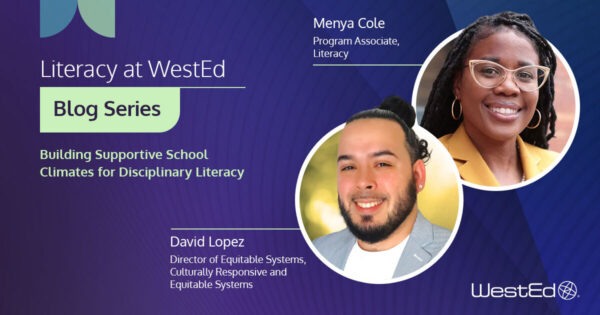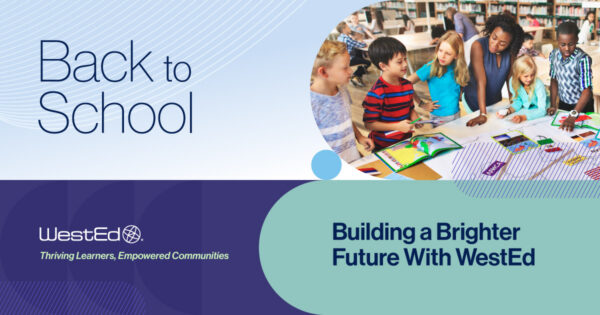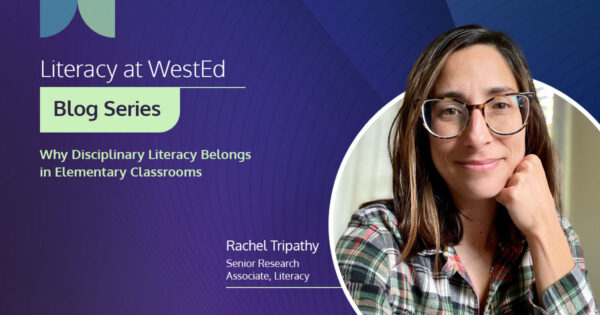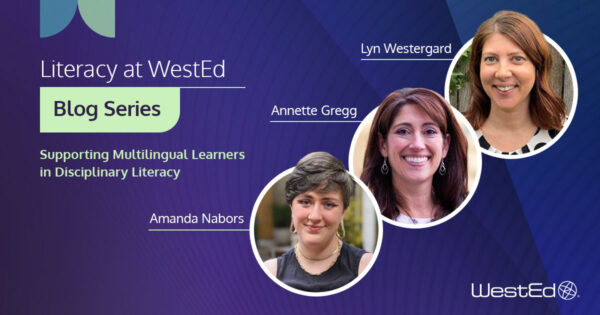
August 4, 2025
By Menya Cole, Heather Conklin, and Priscilla Rodriguez
This blog series explores the concept of disciplinary literacy—the distinct ways of reading, writing, and communicating across academic fields such as science, history, math, and literature. Featuring actionable insights from WestEd thought leaders, the series looks at how integrating disciplinary literacy practices into elementary and secondary classrooms can support student success in school, in careers, and throughout their lives.
Disciplinary literacy (DL) is the ability to read, write, and communicate like experts in a particular field. DL is rooted in the idea that each discipline has distinct ways of producing and sharing knowledge. For example, historians corroborate sources and evaluate perspectives. Scientists design and test hypotheses. Mathematicians justify reasoning. DL teaches students how to use the tools, texts, and language of each discipline while also inviting them to question the assumptions and power structures that shape them. This approach empowers students to become informed thinkers and engaged participants in building and challenging knowledge.
Teachers, as expert readers, writers, and communicators in their disciplines, are uniquely positioned to model and scaffold DL practices. Picture classrooms where students question sources in history, debate conclusions in science, analyze perspectives in literature, and justify reasoning in math. Creating these classrooms requires specific leadership expertise and intentional action. While principals may not lead classroom instruction directly, their leadership is what enables and sustains the conditions for DL to take hold across a school.
What’s the difference between DL and content-area literacy? Content-area literacy focuses on general reading and writing strategies (e.g., summarizing, questioning, identifying key ideas) applied across subjects (International Literacy Association, 2017).
DL, on the other hand, focuses on the unique habits of thinking, reading, and communicating within each subject (e.g., analyzing primary and secondary sources to construct historical arguments in social studies or interpreting diagrams using domain-specific language in science).
As Ortlieb et al. (2024) emphasize, students need access to both general and discipline-specific literacy practices to meaningfully engage with complex texts and be successful in school.
Below are four practices school leaders can use to cultivate a climate in which DL can take root and grow.
Develop a Clear, Instructional Vision
For a principal to lead effectively, they must recognize high-quality instruction, provide feedback that strengthens teacher practice, and invest in professional learning that builds the necessary expertise. This work begins with a clear instructional vision that describes the kinds of teaching and learning students will experience across classrooms.
Principals and their teams can begin to develop a vision by asking a series of questions, such as What does DL look and sound like across classrooms? How are students engaging with the language, tools, and thinking of each discipline? How will teachers support them in constructing, questioning, and communicating knowledge as disciplinary experts? A shared vision helps ensure every classroom reflects the intellectual work of the subject area.
These resources can support developing a vision at your site:
- The Internal Coherence Framework (Forman, Stosich, & Bocala, 2017) supports leaders and their teams in developing a vision to guide meaningful, content-rich learning.
- This tool, drawn directly from the work of Forman, Stosich, and Bocala, is designed to help leadership teams articulate a shared, guiding vision for meaningful, content-rich learning.
Create Purpose and Coherence
A principal’s role in building DL is helping everyone understand how literacy naturally fits into what they’re already doing. Every school has existing priorities, whether it’s improving student engagement, closing achievement gaps, or preparing students for college and careers. Effective principals show how literacy instruction can help achieve those goals more effectively. This means shifting the conversation from “Here’s one more thing you need to do” to “Here’s how we can enhance what we’re already doing.”
Leaders take on the role of culture architects when they make literacy visible not only in words but also through genuine actions that demonstrate how reading, writing, and communication skills unlock deeper learning in science labs, math classrooms, and art studios alike. They create space for authentic collaboration in which teachers establish a common language and have opportunities to peek into each other’s classrooms and think, “Oh, that’s how you get students to really engage with complex texts in history—I wonder how I could adapt that for my chemistry class.”
Through targeted professional learning opportunities and consistent messaging that reinforces literacy as a shared responsibility, principals create the coherence necessary for sustainable DL implementation that genuinely enhances student learning across all subject areas.
This WestEd resource can support planning for coherence at your site:
Build in Systems of Support
Creating lasting change in DL requires building the structural foundation that makes success inevitable. If collaboration around literacy practices isn’t built into the master schedule and backed by real financial investment in curriculum materials, teacher professional learning, and ongoing support, it won’t happen consistently. Smart principals protect collaborative time while also strategically investing in literacy coaches, cultivating teacher leaders, and partnering with external experts who can provide the specialized knowledge that builds internal capacity.
Sustainable change requires creating professional learning structures embedded in the school’s DNA—ongoing, job-embedded learning through coaching cycles, peer observations, and data analysis sessions. This means shifting to accountability systems that support teacher growth, using classroom walk-throughs and feedback as coaching opportunities rather than evaluation tools, and implementing data systems that track both implementation and student outcomes in ways that inform instruction. While test scores are one way to measure efficacy, real success is visible in student voice, confidence, and engagement in academic conversations. Leaders can gather these data through student empathy interviews, instructional walk-throughs, and teacher reflections.
These resources can support planning for implementation at your site:
- Nelsestuen, K., & Smith, J. (2020). Empathy interviews [PDF]. Learning Forward.
- WestEd’s Leading for Systemic Impact: A Reflection Tool for Principals, a tool to help leaders think about leading for systemic impact
Celebrate Successes
Celebrating short-term wins is crucial to sustaining momentum. When leaders highlight instructional shifts and celebrate student growth, they reinforce shared values and build trust. Staff shout-outs, student showcases, data boards and more send a powerful message: We’re making progress, and it matters.
Effective leadership celebrates both progress and people. It honors the diverse ways students show growth and recognizes the collective effort behind shifting schoolwide literacy culture.
These resources can support celebrating success at your site:
- Kotter’s change cycle and celebration of small wins
- WestEd’s Leading Change Reflection, a tool to help leaders think about leading—based on Kotter’s work
- Student Growth With Reading Apprenticeship: Aligning Leadership, Literacy Instruction, and Professional Learning
People, Instruction, and Systems
In a world that demands deep understanding, critical thinking, and effective communication across diverse fields, DL is essential. Research identifies the leadership practices most closely tied to student success: focusing on people, instruction, and systems. These practices are especially critical when leading for DL. When principals develop a clear vision, foster coherence, build lasting systems of support, and celebrate progress, they create the conditions for this work to thrive.
By prioritizing DL, leaders invest in instructional practices that not only raise achievement but also empower students to become confident, capable thinkers in every classroom—and beyond.
Incorporate Disciplinary Literacy Into your Leadership Practice
For more information on how WestEd can support your DL initiative, see the programs and services below:
About the Authors
Menya Cole is a program associate in Literacy at WestEd. She works primarily with the Reading and Writing Apprenticeship teams, helping educators nationwide implement DL strategies that improve student engagement and academic outcomes.
Heather Conklin is a senior program associate in Literacy at WestEd. She designs, facilitates, and supports professional learning initiatives for Reading Apprenticeship while also providing guidance and expertise on enhancing literacy outcomes to schools, districts, and educational agencies nationwide.
Priscilla Rodriguez serves as the project director of Educational Leadership for WestEd’s Educational Leadership and System Design team where she provides professional development and coaching to systems leaders, principals, and instructional coaches in the area of instructional leadership.










